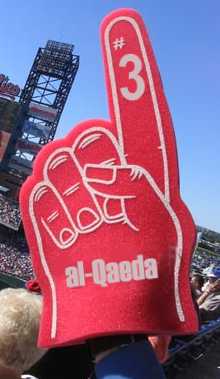|
|
|
Image courtesy of Rantburg. |
It is always interesting to watch the press coverage when the rumors begin to fly after a senior al Qaeda leader is thought to have been killed in a US airstrike inside Pakistan. Invariably, after it is determined that Osama bin Laden and Ayman al Zawahiri were not killed in the attack, a news organization or two almost always identifies the thought-to-be-slain al Qaeda leader as the Number Three, or the third in the chain of command. This happened yesterday, when Abu Yahya al Libi was rumored to have been killed (that rumor was incorrect, as Saleh al Somali, al Qaeda’s external operations chief, was later identified as the operative thought to have been killed). Here is how CBS News described al Libi:
Earlier, Pakistan media had incorrectly reported that the strike killed al Qaeda’s number 3 in command, Abu Yahya al-Libi.
This isn’t to single out CBS News; it won’t be the first or last organization to do this. Previously, news organizations ihave dentified Abu Hamza Rabia (operations chief, killed in December 2005), Abu Laith al Libi (military commander, killed in January 2008), Osama al Kini (external operations chief, killed in January 2009), and a host of al Qaeda leaders as the number 3 after their deaths. While each of these men were top al Qaeda leaders, identifying them as the third in command (a position that many intelligence officials I speak to do not believe even exists) does little to further the understanding of al Qaeda’s network.
Are you a dedicated reader of FDD's Long War Journal? Has our research benefitted you or your team over the years? Support our independent reporting and analysis today by considering a one-time or monthly donation. Thanks for reading! You can make a tax-deductible donation here.









1 Comment
Interesting comments.
The problem is people are thinking in terms of a rank order when this is organizational tree (or graph in the more general case … yes, I’m a geek). Perhaps another way of looking at it is one of the quotes from CBS source said he was in the “AQ top 5”.
Clearly there are tiers in the hierarchy with tier 1 being UBL and AZ (and perhaps the long dead Atef? The original #3). The question is how many are in tier 2 (which is perhaps 3 given the top five comment), who are they, what do they do and how do they report to others.
And then there’s tier 3 (and perhaps down to cells after that) who report to those tier 2 people. Perhaps the person taken out in Celestial Balance was the tier 3 man for Somalia.
Understanding this (and the communication methods between the nodes) are essential to take out tier 2 and 3 people. And perhaps lead you to tier 1. But I suspect that last link is a rather low bandwidth, high latency and low tech to avoid being traced back.
Perhaps if the AQ organizational structure was better known in public perhaps the better reporters would move away from the simplistic “number 3” approach. But I suspect that info is very classified.